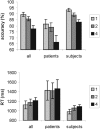Sustained neural activity patterns during working memory in the human medial temporal lobe
- PMID: 17634374
- PMCID: PMC6672876
- DOI: 10.1523/JNEUROSCI.0962-07.2007
Sustained neural activity patterns during working memory in the human medial temporal lobe
Abstract
In contrast to classical findings that the medial temporal lobe (MTL) specifically underlies long-term memory, previous data suggest that MTL structures may also contribute to working memory (WM). However, the neural mechanisms by which the MTL supports WM have remained unknown. Here, we exploit intracranial EEG to identify WM-specific sustained activity patterns with the highest temporal and spatial resolution currently available in humans. Using a serial Sternberg paradigm, we found a positive shift of the direct current (DC) potential and a long-lasting decrease in MTL gamma-band activity during maintenance of a single item, reflective of a sustained reduction in neural activity. Maintenance of an increasing number of items elicited an incrementally negative shift of the DC potential and an increase in MTL gamma-band activity. In addition, the paradigm was conducted in healthy control subjects using functional magnetic resonance imaging. This confirmed that our results were not caused by pathological processes within the MTL, and that this region was indeed specifically activated during the task. Our results thus provide direct evidence for sustained neural activity patterns during working memory maintenance in the MTL, and show that these patterns depend on WM load.
Figures







References
-
- Aggleton JP, Shaw C, Gaffan EA. The performance of postencephalitic amnesic subjects on two behavioural tests of memory: concurrent discrimination learning and delayed matching-to-sample. Cortex. 1992;28:359–372. - PubMed
-
- Axmacher N, Mormann F, Fernandez G, Elger CE, Fell J. Memory formation by neuronal synchronization. Brain Res Rev. 2006;52:170–182. - PubMed
-
- Brett M, Anton JL, Valabregue R, Poline JP. Region of interest analysis using an SPM toolbox. the Eighth International Conference on Functional Mapping of the Human Brain; June; Sendai, Japan. 2002. Abstract presented at.
-
- Cave CB, Squire LR. Intact verbal and nonverbal short-term memory following damage to the human hippocampus. Hippocampus. 1992;2:151–163. - PubMed
Publication types
MeSH terms
Substances
LinkOut - more resources
Full Text Sources
